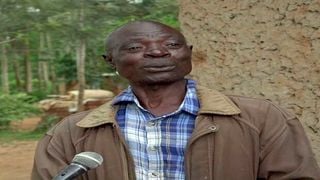
Mr John Kisaka, who underwent corrective surgery to remove a lump on his back. Scientists are investigating the cause of abnormal growths and tumours in three villages in Bungoma County.
| PoolBungoma
Premium
Mystery of patients with growths in Bungoma villages
Plush sugarcane and maize plantations welcome you to the villages of Nabiswa, Nasianda and Chwele in Bungoma County.
But beneath this beauty is a mysterious disease that has struck at least 50 people in these villages.
The people, according to local hospital records, have growths or lumps on various parts of their bodies, which scientists now say need to be investigated immediately.
Some are cancerous, oncologists have said, while others are not, but it is not yet clear why the big numbers of people affected in the three villages.
To worsen the situation, villagers believe it is witchcraft, which often leads them to quack doctors that cut the growths with razor blades, while the patients shun going to hospital.
At Sibumba Secondary School, we find Sharon Mutoro, a Form Three student. The growth protruding from her neck makes her stand out in her chemistry class.
The growth began as a tiny pimple and the more she scratched it, the more it grew, until it became too big to go unnoticed, she says.
“This growth has made my life unbearable. I have moved from one hospital to the next,” says Mutoro.
Dr Simon Kisaka, the medical superintendent at Webuye County Hospital, says the majority of people whose lumps are cancerous visit the hospitals when it is too late.
Cancer
“The challenge we are having as a facility, and as a community, is that we are having our clients coming in late for treatment. Most cancers, when caught early, can be easily treated. Most cancers have four stages; stage I, II, III and IV. Stage I and II, when got early, can be completely cured. So, I want to make an appeal to the public and the community to come for screening,” he says.
Currently, the hospital has been training community health volunteers to identify those who require treatment.
Concerned over the rising cases, a nurse from Webuye Hospital, Ms Florence Wabomba, has been using her free time to sensitise community members on this condition besides helping the affected people to access treatment.
Through her efforts, she says, more than 100 patients have undergone corrective surgery.
“Because I have their photos, I meet my friends, I share these pictures … the case will be picked and various partners have come up to pay the bills,” says Ms Wabomba.
One of these is Brigit Namwenya.
Married to Jamin Kipanga, Ms Namwenya says the growth had for long affected her life and marriage.
“When I married her, she didn't have any growth. It just came from nowhere. She had lived with it for 20 years until we met nurse Florence Wabomba, who helped us,” says her husband.
When the Nation visits, Ms Namwenya has just come from surgery, happy that something is being done to help her.
“I was really devastated with this growth. Before undergoing the operation, I would visit a home and be served tea or porridge, but when I am done, they would destroy the cup I had used,” she says.
Interestingly, her father also had a similar growth, pointing to a hereditary cause in her case.
Ms Joyce Alivitsa Ombacho has also benefited from Ms Wabomba’s initiatives.
Ms Ombacho explains that her growth started when she was seven months pregnant and it could be seen whenever she swallowed food.
It was painless, and kept growing, and 25 years later, the growth had enlarged to engulf most of her neck.
Carrying out tests
“I have visited Aga Khan hospital in Kisumu without any breakthrough. I have also gone to another hospital called Heaven, no relief as well as Mukumu hospital (in Kakamega). When carrying out tests, they only used to tell me that it is not deeply rooted and yet here it is,” says Ms Ombacho.
Being a vegetable vendor, the growth made life unbearable for her because many people were not comfortable buying from her.
Dr Kevin Makori, a clinical and radiation oncologist at the International Cancer Institute in Eldoret, says while it is curious that the villages have such a high number of the abnormal growths, a scientific study is required to establish why the prevalence.
“Whenever such geographical clustering of a medical condition is noted, it usually raises suspicion that there could either be a common environmental trigger, or inherited defects. This is because our social set up, especially in the rural areas, is such that people of shared ancestry often live within the same locale, and tend to have similar socio-cultural practices. Until such evidence is found however, it would be safe to say that these are conditions that can occur in individuals across the world,” Dr Makori tells the Nation.
He says there is a possible genetic connection to the abnormal growths.
“It is also possible that such genetic changes may be inherited from our parents or occur as a result of substances within our environment. If the body is not able to control such changes, abnormal and destructive growth may occur, which at the basic level is the origin of cancer,” he says.
The Eldoret-based oncologist warned against attributing the swellings to witchcraft or other spiritual beliefs.
“Attributing these swellings to witchcraft is harmful; it stigmatises individuals, who then fail to seek appropriate and potentially curative treatment.”
The Covid-19 pandemic has also slowed down the management of non-communicable diseases such as tumours.
“As much as the focus is on Covid-19 pandemic at the moment, there other issues of dental care that should be looked at for example patients with neck and head growth who have not been able to be seen at the facilities,” says Dr Sharon Lelei, a dentist at St Luke’s Orthopaedic and Trauma Hospital in Eldoret.






